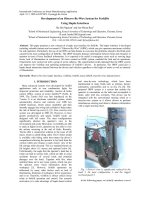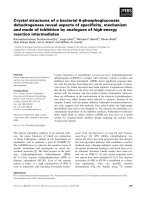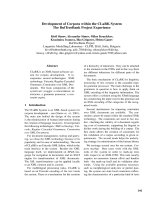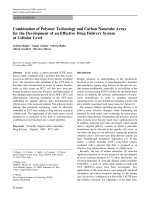Development of high energy dissipation composite system utilizing shear thickening materials
Bạn đang xem bản rút gọn của tài liệu. Xem và tải ngay bản đầy đủ của tài liệu tại đây (1.9 MB, 117 trang )
DEVELOPMENT OF HIGH ENERGY DISSIPATION COMPOSITE
SYSTEM UTILIZING SHEAR THICKENING MATERIALS
PHYO KHANT
A THESIS SUBMITTED
FOR THE DEGREE OF MASTER OF ENGINEERING
DEPARTMENT OF CIVIL AND ENVIRONMENTAL ENGINEERING
NATIONAL UNIVERSITY OF SINGAPORE
2011
Acknowledgements
I would like to express my deep and sincere gratitude to my supervisors, Professor
Liew Jat Yuen Richard and Associate Professor Tan Beng Chye Vincent, for their
valuable guidance and support throughout the course of this project.
Special thanks goes to Dr Davy Cheong for his kind guidance as well as his
constructive advice and encouragement from beginning to end of my research work.
I gratefully acknowledge to Ang Kah Yee (National Junior College), Wong Ting
Chong and Sai Murugan Pandit (FYP students from Mechanical Engineering,NUS)
for their valuable assistance and contributions to my research work.
I would like to express my gratitude to the lab officers of NUS Impact Lab, Mr. Alvin
Goh and Mr. Joe Low for their help and timely advice.
I especially want to thank my wife for her understanding, support and motivation.
i
Table of Contents
Table of Contents
Acknowledgements…………………………………………………………………….i
Table of Contents…...…………………………………………………………………ii
Summary………...……………………………………………………………………vi
List of Figures ………………………………………………………………….…...viii
List of Tables..…………………………………………………………………….....xii
1
Introduction……..…………………………………………………………………...….…1
1.1 Objectives…...………………………………………………………...…………..….3
1.2 Scope ………………………………………………………………………..………4
2
Literature Review …………………………………………………………………….…5
2.1 Soft body armor…………………………………………………………...……….…5
2.2 Behind armor blunt trauma...…………………………………………………………6
2.3 Shear thickening fluids……..………………………………………………...………8
2.3.1 Mechanism of shear thickening
…………………………………..………..10
2.3.2 Order-disorder theory…………………………………………………..……..10
2.3.3 Hydrocluster theory…………………………………………………...………11
2.3.4 Applications of shear thickening fluids ….…………………………….…..…12
3
Drop Impact response of shear thickening fluids…………………………………..…….13
3.1 Introduction………………………………………………………………..…….….13
3.2 Experiment…………………………………………………………...……………..14
3.2.1 Materials.............................................................................................................14
3.2.2 Experimental set-up and test method..................................................................15
3.3 Results and discussion................................................................................................16
3.4 Conclusion..................................................................................................................20
4
Reducing blunt trauma with shear thickening fluids……………………………..………21
4.1 Introduction……………………………...………………………………………….21
ii
Table of Contents
4.2 Experimental set-up……………………………………..…………..………………22
4.2.1 Test materials……………………………………………..…………………..23
4.2.1.1 Shear thickening fluids………………………………………..…………23
4.2.1.2 Ballistic fabric
…………………………………...………………..23
4.2.1.3 Clay backing……………………………………………….…………….25
4.2.2 Experimental method…………………………………………..……….……...25
4.3 Ballistic limit for the Twaron CT717 fabric
………….………………………..26
4.4 Blunt trauma tests on STF packages with different concentration ……...…………..27
4.5 Development of STF-fabric composite pad
………………………….………..29
4.5.1 Effectiveness of different combination of composite systems
for blunt trauma reduction……………………………………………………29
4.5.2 The effectiveness of STF at impact velocity of 145 m/s………………...…….31
4.5.3 The effectiveness of epoxy treated Twaron fabric in
STF packages………………………………………………………………......32
4.5.4 The effectiveness of STF-fabric composite system…...………………...……..34
4.6 Development of STF-fabric blunt trauma pad..……………………………...……..36
4.7 Energy dissipation mechanism of STF-fabric composite pad…..…………………..38
4.8 Conclusion…………………………………………………………………………..41
5
Reducing blunt trauma with shear thickening polymers………………………………....43
5.1 Introduction……………………………………………...………………………….43
5.2 Experimental set-up and method of testing…………………………..……………..44
5.3 Effectiveness of shear thickening polymer (STP)-fabric composite pad…………46
5.4 Performance comparison of STP and STF composite pad…..………….…………..49
5.5 Ballistic impact tests with varying thickness of STP composite pad……………53
5.6 Mechanism for DOP reduction due to interaction between
STP and Twaron fabric…………………….…………………….………………….54
5.7 Conclusion………………………………………………………………………….56
6
Improving ballistic limit with shear thickening polymers ………………………..……..57
iii
Table of Contents
6.1 Introduction…………………………………………………………………………57
6.2 Experimental set-up and test materials………..…………………………….………58
6.2.1 Experimental set-up……………………….…………………………………...58
6.2.2 Test materials……………………..……………………………………………59
6.2.2.1 Ballistic fabric.………………………………………………………..…59
6.2.2.2 Shear thickening polymer (STP) pad…………..……………………..…59
6.3 Results and discussion………………………………………….…………….……..60
6.3.1 Ballistic limit (BL) for STP composite pad………………...………………….60
6.3.2 Energy absorption capacity of STP pad…..…………………………………...63
6.4 Conclusion…………………………………………………………………………..65
7
Incorporation of epoxy treated Twaron fabric for impact protection…………….………66
7.1 Introduction…………………………………………………………………………66
7.2 Test materials and methods………………………………………………………....67
7.3 Ballistic performance of stacking sequence of neat and
epoxy treated fabric plies…………..……………………………………………….69
7.4 Mode of deformation and energy absorption mechanisms…...…………………….75
7.5 Ballistic impact tests on epoxy treated Twaron fabric with
STP – fabric composite blunt trauma pad ........................................................….....76
7.6 Conclusion……………………………………..…………………………………....77
8
Application of shear thickening polymers in hip protectors……………………………..79
8.1 Introduction…………………………………...…………………………………….79
8.2 Materials and testing method…………..………...………………………………....80
8.3 Results and discussion…………….………………………………………………...82
8.4 Conclusion…………………………………………………………………………..85
9
Conclusion………………………………….…………………………………………….86
10 References………………………………………………………………………………..89
Appendix A
Compression of clay backing………………………………………...96
iv
Table of Contents
Appendix B
Measurement of DOP in clay backing……………………………….97
Appendix C
Fibrous surfaces used for ballistic impact test on STP packages….....98
Appendix D
Dimensions of metal box containing clay backing………………......99
Appendix E
Dimensions of wooden box containing clay backing……………….100
Appendix F
Detailed results for ballistic tests on STP packages………………...101
Appendix G
Detailed results for ballistic impact (blunt trauma) tests
on STP packages…………………………………………………....102
Appendix H
Detailed results for ballistic impact test for epoxy treated
Twaron fabric systems………………………………………….…..104
v
Summary
Summary
In this research, novel impact energy dissipation composite systems which utilize
shear thickening materials is developed and explored. With the aim of reduction nonperforating behind armor injuries, flexible impact energy dissipation systems using
cornstarch-water suspension as the shear thickening fluids (STF) were fabricated and
tested.
Firstly low velocity impact response of the shear thickening fluid with
different concentration was performed. The performance of impact resistance was
investigated in terms of penetration depths in clay witness placed behind the STF. The
concentration of 58.82wt% of cornstarch showed the best performance in resisting
impact forces.
A new composite system comprising woven Twaron ballistic fabric impregnated with
shear thickening fluid is introduced next. The ballistic impact response of the system
was studied. Impact tests suggest that the combination of the fabric layers and shear
thickening fluids resulted in greater impact energy dissipation. It was also shown that
developed STF-fabric pad is effective in reducing blunt trauma.
Thereafter, a new shear thickening material was introduced and a shear thickening
polymer (STP)-fabric composite pad was developed. The effectiveness of the STP
with different composite layers was studied. The STP pad containing 4 plies (2 x 2) of
epoxy treated Twaron gave the lowest depth of penetration in clay witness. Results
showed that the STP is most effective in reducing blunt trauma when used in
conjunction with armor fabric due to the interaction between both materials. This
interaction results in greater energy absorption and dissipation possibly due to
vi
Summary
increased stiffness, viscous dissipation and increased inter-yarn friction caused by
shear thickening of the STP during impact. The 6 mm thick STP-fabric composite pad
was found to reduce blunt trauma by 25% when placed behind flexible body armor.
The study also investigated the effects of adding epoxy treated layers in fabric
systems. Results showed that the addition of epoxy treated layers was effective in
reducing blunt trauma and this is attributed to increased stiffness, inter-yarn friction
and fabric projectile friction. Additionally, the placement of neat layers in front of
treated layers in fabric systems was found to be most effective in reducing blunt
trauma. This suggests that the stacking sequences of neat and epoxy treated fabric
plies are found to be important in improving protective performance, which affected
not only the back face signature (BFS) but also the ballistic limit.
vii
List of Figures
List of Figures
Figure 2.1 Wave propagation in soft body armour due to projectile impact……...…5
Figure 2.2 Classification of fluids based on the stress versus rate of
strain relationship……………………………..…………………………..8
Figure 2.3 Shear thickening behavior (viscosity vs shear rate) of 57 and 62
volume % colloidal silica dispersed in ethylene glycol for
steady shear flow….……………………………………………….…..…9
Figure 2.4 Hydrocluster theory for shear thickening suspension morphology…..…11
Figure 3.1 Micrograph of cornstarch particles………………………………….…..14
Figure 3.2 Steady-state shear rheology of 55wt% cornstarch in water suspension...14
Figure 3.3 Drop tower set-up ……………………………………………………....15
Figure 3.4 Perspex acrylic container with clay witness for drop testing……………15
Figure 3.5 Photo of Twaron fabric with aluminum legs………..………….……….15
Figure 3.6 Depth of penetration in clay backing for 0.5m drop tests onto
10 mm of STF …………………………………………………….…….17
Figure 3.7 Depth of penetration in clay backing for 0.5m drop tests onto
20 mm of STF …………………………………………………….…….18
Figure 3.8 Penetration depth versus drop impact energy from drop tests onto
20 mm STF at 58.82wt% concentration .……………………………......19
Figure 3.9 Shear thickening zones developed upon impact onto STF
covered by Twaron fabric with aluminum legs……………..…………..20
Figure 4.1 Thin rubber encapsulated cornstarch suspension for impact
absorption ………………………………………………………….…..23
Figure 4.2 Clay witness…………………………...…………………………….…..25
viii
List of Figures
Figure 4.3 Schematic diagram of high pressure gas gun set-up for ballistic
tests……………………………………………………………………...25
Figure 4.4 Depth of penetration in clay witness for systems of different
concentration of STF covered with 1 ply of Twaron for ballistic
tests at 75 m/s…….…………………………………………...……...…28
Figure 4.5 Depth of penetration in clay witness for different STF
composite systems for ballistic test at 75 m/s…………..……………….30
Figure 4.6 Depth of penetration in clay witness for STF and water systems
of same thickness of 20 mm for ballistic tests at 145 m/s……………....31
Figure 4.7 Depth of penetration in clay witness for STF systems of same
weight of 255g for ballistic tests at 145 m/s…………….........................33
Figure 4.8 Depth of penetration in clay witness for systems without STF for
ballistic tests at 145 m/s……………………………………………..…..34
Figure 4.9 Depth of penetration in clay witness for systems of same weight
of 255g for ballistic tests at 145 m/s……………………...…………..…35
Figure 4.10 Depth of penetration in clay witness for systems of same thickness
of 20 mm for ballistic tests at 350 m/s…..…………......................…......37
Figure 4.11 Front (Left) and back face (Right) of STF-fabric
composite pad after 350 m/s impact……………..……………………...38
Figure 4.12 Clay witness after projectile impact at 350 m/s for STF-fabric
composite pad (Target D)…………...…………………………………..38
Figure 4.13 Impact sequence of STF-fabric composite pad………………...………..40
Figure 4.14 Damage in integrated plies after impact…………………………...…....41
Figure 5.1 Target set-up for assessing blunt trauma in ballistic testing………..…...44
ix
List of Figures
Figure 5.2 Shear thickening polymer (STP) pad (Left) and shear thickening
fluid (STF) pad (Right)……………………………...…………………..45
Figure 5.3 Depth of penetration in clay witness for STP systems of same
thickness of 15mm for ballistic tests at 150 m/s……….………………..46
Figure 5.4 Depth of penetration in clay witness for STP-epoxy systems
of same thickness of 15 mm for ballistic tests at 150 m/s ………….…..48
Figure 5.5 Comparison of depths of penetration in clay witness for STP and
STF systems of same thickness of 15 mm for ballistic tests at 150 m/s
(without fibrous interlayer)…….………………………………………..50
Figure 5.6 Comparison of depths of penetration in clay witness for STP and
STF systems of same thickness of 15 mm for ballistic tests at 150 m/s
(with fibrous interlayer)………….………………………………….…..51
Figure 5.7 Comparison of depths of penetration in clay witness for STP and
STF systems of different weight and thickness for ballistic
tests at 150 m/s…………………………………………………………..52
Figure 5.8 Shear thickening in STP due to transverse deflection (Left) and
In-plane deflection (Right) of fabric……………………………….……54
Figure 6.1 Target set-up for obtaining ballistic limit……………………………….59
Figure 6.2 Residual velocity for systems with and without STP at striking
velocity of 400 m/s……………………………..……………..………...64
Figure 6.3 Energy absorbed by systems with and without STP at the impact
energy of 960 J…………………………………………………….….....65
Figure 7.1 Set-up for measuring the flexibility of test system…………….………..69
Figure 7.2 Depth of penetration in clay witness for systems with combinations
of neat and epoxy treated Twaron fabric for ballistic tests at 330m/s
x
List of Figures
(epoxy treated plies placed at backface)……………….………………..70
Figure 7.3 Depth of penetration in clay witness for systems with combinations
of neat and epoxy treated Twaron fabric for ballistic tests at 330m/s
(epoxy treated plies placed at striking face)……………………….…....71
Figure 7.4 Percentage of perforated plies for systems with combinations of
neat and epoxy treated Twaron fabric for ballistic tests at 330m/s…....72
Figure 7.5 Average depth of penetration in clay witness versus percentage of
perforated plies for neat-epoxy treated systems for ballistic tests
at 330m/s………………………………………………..…………….…73
Figure 7.6 Average depth of penetration in clay witness versus bending angle
for neat-epoxy treated systems…………………………….……………74
Figure 7.7 A perforated layer neat fabric (Left) and epoxy treated fabric (Right)....75
Figure 7.8 Depth of penetration in clay witness for neat-epoxy treated composite
systems with and without STP for ballistic tests at 350 m/s………….....77
Figure 8.1 Hip protectors : (top left) Hip Saver; (top right) Safehip; (bottom left)
Hornsby hip protector; (bottom right) Impactwear® shields. ……...…..80
Figure 8.2 Flexible shear thickening polymer pads (left) 15 mm thick;
(right) 25 mm thick …………………………………………………......80
Figure 8.3 Drop weight impact set-up for testing hip protectors …………….…….81
Figure 8.4 Average peak force transmitted through hip protectors for impact
energy of 1.467 J ………………………………………………………..84
Figure 8.5 Force transmitted through hip protectors versus time for impact
energy of 1.467 J…………...……………………………………………84
xi
List of Tables
List of Tables
Table 4.1 Twaron CT717 fabric specifications…………………..…………….…...24
Table 4.2 Properties of Twaron fibres………………………….………..………….24
Table 4.3 Results of ballistic tests on 1 ply of Twaron CT717 fabric………..…......27
Table 4.4 Results of ballistic tests on 2 plies of Twaron CT717 fabric……….…....27
Table 5.1 Depth of penetration in clay witness for different thickness of
STP pad with frontal fabric layers……………………………………......53
Table 6.1 Description of systems tested for ballistic limit……………...…….…….60
Table 6.2 Results of ballistic tests for 2 plies of Twaron fabric (System A)…….…61
Table 6.3 Results of ballistic tests for 2 plies of Twaron fabric and 4 plies
of epoxy treated Twaron (System B)……………………………....….…61
Table 6.4 Results of ballistic tests for 2 plies of Twaron fabric and
15mm thick STP pad (System C)…………………………..……….……61
Table 7.1 Areal densities of different combination of neat and epoxy treated
Twaron fabric……………………………………………….…………....68
Table 8.1 Description of hip protectors…...………………………………………...81
xii
Chapter 1 Introduction
1 Introduction
The main function of anti-ballistic body armor is to provide protection to the wearer
by resisting projectile penetration and reducing its kinetic energy. However, even if
the projectile does not perforate the armor, the armor may deform significantly when
the projectile is stopped causing injury to the wearer. This is known as blunt trauma.
The degree of blunt trauma experienced by the wearer depends on the extent of
inward deformation of armor after impact [1]. A number of new concepts have been
proposed to reduce blunt trauma caused by back-face deformation.
Recent studies have shown that good improvement in the ballistic resistance of fabric
armor materials can be achieved when they are impregnated with a shear thickening
fluid [2]. Various commercial products have also utilized polymeric materials with
shear thickening properties for low velocity impact shock absorption in sports and
industrial applications. This suggests that it may be also possible to utilize shear
thickening materials for reducing high velocity ballistic impacts.
Shear thickening fluids have fueled much interest in the field of personal protection
and are currently widely studied because of their unique ability to transform from a
low viscous to a high viscous state almost instantaneously. This ability makes them
ideal for energy absorption applications. While the fluid is in a low viscous state
under normal conditions, it allows for user mobility and flexibility, but as it undergoes
shear-thickening when subjected to an impact, it absorbs some of the energy of the
impact while helping to dissipate the remaining energy.
1
Chapter 1 Introduction
Shear thickening fluids are also of particular interest because of their “method of
deployment” or activation. They do not need any external activation from the user,
but will activate when subjected to a critical stress loading. The armed forces are
particularly interested in these fluids as there is a pressing need for personal
protection gear that is efficient in energy absorption yet still flexible enough to wear
in combat where soldier mobility and comfort are vital.
Particularly promising is the application of these fluids for Traumatic Brain Injury
(TBI) protection and Primary Blast Injuries (PBI) mitigation. Mitigation of these
injuries can potentially benefit from the development of shear thickening fluid based
composites as they require materials that have the potential of absorbing large amount
of energies while maintaining flexibility and comfort during normal use.
In this work we investigate how shear thickening fluids can be efficiently utilized as
part of energy absorbing composites for blunt trauma applications. For this purpose, a
STF-fabric composite system will be developed. The shear thickening properties of
cornstarch–water suspension (STF1) will be exploited for use in high velocity impact
absorption, particularly to reduce behind amour injuries. A proof that such a system
can effectively reduce such injuries is sought. To achieve this, a series of tests
designed to replicate the impact conditions generating behind amour injuries will be
performed. Twaron fabric, commonly used in soft body armor, is packaged with the
cornstarch-water suspension (STF) in different configurations and performance
indicators are measured and analyzed.
1 – For subsequent parts of this thesis, cornstarch-water suspension shall be referred to as STF
2
Chapter 1 Introduction
Thereafter, flexible blunt trauma pads made from polymers with shear thickening
properties (STP) will be subjected to testing. Although, polymers with shear
thickening properties are commonly used for protective gears in the sports industry,
the concept of using them for body armor blunt trauma protection is relatively new. In
these tests, the effectiveness of blunt trauma pads made from shear thickening
polymer (STP) in reducing blunt trauma will be investigated and alternative systems
to improve ballistic properties of existing soft body amour will be proposed.
Subsequently, the ballistic performance of the STF and STP will be compared and
discussed.
In addition, the ballistic performance of epoxy treated Twaron fabric will also
investigated as studies have been shown that the friction between the yarns of fabric
can be increased by applying a thin layer of epoxy onto the neat fabric. Furthermore,
the effect of stacking sequence of neat and epoxy treated fabrics will be discussed
based on their ballistic performance and flexibility.
1.1 Objectives
The main objectives of this investigation are as follows:
To study the low velocity impact (i.e., drop impact) response of the STF
To develop and evaluate the effectiveness of STF-fabric composites in
absorbing high velocity impacts
To develop and evaluate the effectiveness of STP-fabric composites in
absorbing high velocity impacts
3
Chapter 1 Introduction
To investigate the effect of stacking sequence of neat and epoxy treated
ballistic fabrics in absorbing impact energy
1.2 Scope
The scope of this study encompasses the followings:
To conduct drop testing to study the low velocity impact response of the STF.
To conduct ballistic impact tests based on NIJ standard 0101.06 using 12 mm
diameter spherical shape projectiles fired from a helium gas gun to study the
high velocity impact response of the STF/STP-fabric composite systems.
To explore the application of the STP-fabric composite system.
4
Chapter 2 Literature Review
2 Literature Review
2.1 Soft body armor
Through history, humans have used various types of soft body armor such as animal
skin, chain mail, silk and nylon, etc., to protect themselves from injury in combat.
Nowadays, soft body armor is usually made up of high strength materials that can be
woven into a lightweight fabric with excellent ballistic resistant properties.
Traditional soft body amour materials, such as Kevlar, Twaron and Spectra have been
extensively used for flexible personnel body protection due to their high strength and
light weight characteristics [3]. Soft body armour consists of multiple layers of fabric.
When a projectile strikes the fabric, it is caught in a web of yarns to which its kinetic
energy is transferred [1]. As a result, two waves, in-plane and transverse, propagate
from the point of impact (Figure 2.1).
Yar
n
Figure 2.1: Wave propagation in soft body armour due to projectile impact [4]
This kinetic energy, carried by the stress waves, is dissipated through yarn
deformations and inter-yarn friction when they slip or slide against each other [4]. The
energy is absorbed by each successive layer of the fabric until the projectile is
stopped. Excessive impact energy may cause material damage such as fabric tear or
5
Chapter 2 Literature Review
slit [1]. Factors affecting the ballistic performance of fabric armour include the fabric
material properties, weave architecture, inter-yarn friction, fabric-projectile friction,
interaction between layers and projectile geometry [4].
2.2
Behind armor blunt trauma
In addition to stopping bullets, body armor also has to protect users against blunt
trauma due to the high momentum and kinetic energy of bullets. This is because even
though the bullet does not contact the body, some of the kinetic energy may be
transferred through the armor backing and body wall, causing injury to the internal
organs. This form of non-penetrating injuries resulting from the impact of projectiles
is commonly termed behind armor blunt trauma (BABT) [5].
Behind armor blunt trauma (BABT) is the spectrum of non-penetrating injuries
resulting from the rapid deformation of armor covering the body [5]. The deformation
of the surface of the armor in contact with the body wall arises from the retardation
and energy absorbing process that captures the impacting projectile. This deformation
applies shear to the local underlying tissues and causes them to accelerate suddenly.
This generates stress and shear waves that propagate through the body and damage
tissue and internal organs. The type and severity of injuries from blunt impact are
dependent upon the magnitude of the deflection of the body wall, and most
importantly upon the rate of the deflection [5].
To increase protection against blunt trauma, the usual method is to add more fabric
layers or ceramic inserts. However, this is done at the expense of increasing weight of
6
Chapter 2 Literature Review
the amour and reducing the wearer‟s mobility [3]. The addition of blunt trauma pads
has become an alternative solution to reduce blunt trauma caused by backface
deformation. Such pads are positioned between the bulletproof vests and body to
provide additional protection for critical areas like the heart and lungs. There have
already been applications of such pads for protective gears used in sports and heavy
industries. However, they are not widely used in the development of body armor.
In soft ballistic armor, deformations due to bullet impact are much larger than in hard
armors. This give rise to another form of behind armor injury termed the backface
signature injury (BFS). This was defined by Bir [6], roughly, as an “open penetrating
wound that occurs even though the bullet did not penetrate the vest”. The BFS causes
a much more localized damage than BABT. Although the exact mechanism of how
BFS occurs is unknown, a study done by Bir et al [6, 7] suggests that an important
parameter creating the injury is the energy density or the energy per unit area of the
deforming fabric.
Therefore, a person wearing armor may be exposed to two kinds of injury even if the
armor is not penetrated. A hybrid injury pattern arising from BABT and BFS is term
“penciling” or “ballistic punch” in the literature [6]. However, for simplicity and
consistency with commonplace usage, we shall use the term blunt trauma to refer to
all forms of behind armor injury.
7
Chapter 2 Literature Review
2.3 Shear thickening fluids
A dilatant, which is also termed shear thickening material, is one in which viscosity
increases with the rate of shear. The dilatant effect can be found when closely packed
particles are combined with enough liquid to fill the gaps between them. At low
velocities flow, the liquid acts as a lubricant, and the dilatant flows easily. At higher
velocities flow, the liquid is unable to fill the gaps created between particles, and
friction greatly increases, causing an increase in viscosity.
A shear thickening fluid is an example of a non-Newtonian fluid, a fluid whose flow
properties differ in any way from those of Newtonian fluids. Most commonly,
the viscosity of non-Newtonian fluids is not independent of shear rate or shear rate
history. In a Newtonian fluid, the relation between the shear stress and the shear rate
is linear, passing through the origin, the constant of proportionality being the
coefficient of viscosity. In a non-Newtonian fluid, the relation between the shear
stress and the shear rate is different, and can even be time-dependent.
Bingham Plastic
Shear Stress, t
Pseudoplastic Fluid
Dilatant Fluid
Newtonian Fluid
Shear Rate, k
Figure 2.2: Classification of fluids based on the stress versus rate of strain relationship
8
Chapter 2 Literature Review
Shear thickening fluids are also referred to as „field-activated‟ fluids. This
phenomenon is described as a step like increase in viscosity when the applied rate
reaches a critical value; the fluids having low viscosity at imposed rates lower than
the critical value, and high viscosity when rate exceeds the critical value. The shear
thickening behavior can be continuous when the fluid viscosity gradually increases
after the critical shear rate or discontinuous if the viscosity jumps from one value to
another at one specific shear rate as in the case illustrated in Figure 2.2.
Shear thickening fluids are composed of highly concentrated suspensions dispersed in
a carrier fluid. The thickening behavior of these suspensions is normally seen at high
volume fraction so that the particles are dense enough that their average separation in
equilibrium conditions is less than the particles diameter and therefore multiple-body
and lubrication between the particles are of importance [8]. The shear thickening
behavior of these fluids have been studied for well over a half century [8, 9, 10, 11,
12].
Figure 2.3: Shear thickening behavior (viscosity vs shear rate) of 57 and 62 volume %
colloidal silica dispersed in ethylene glycol for steady shear flow. [2]
9
Chapter 2 Literature Review
2.3.1 Mechanism of shear thickening
In the case of extreme or discontinuous shear thickening behavior, the fluid response
at the critical shear rate has been difficult to study since most rheometers are operated
by controlling the imposed deformation rate. Recently, the shear thickening
phenomenon was studied with the help of improved stress controlled rheometers and
additional techniques which can characterize the corresponding microstructure [1318]. Additionally, computer simulations have recently contribute to the understanding
of the shear thickening mechanism. Stokesian Dynamic techniques [19-22] are
commonly used to simulate the behavior of many-body interactions in the suspension,
but other methods, like dissipative particles dynamics [23], and the Lagrange
multiplier fictitious domain method [24] are also used. Two different mechanisms
have been proposed from such calculations to explain these fluids behavior - the
Order-Disorder theory and the „Hydrocluster‟ theory.
2.3.2 Order-disorder theory
The order-disorder mechanism was introduced by Hoffman [25] who observed that
mono-disperse suspensions under shear generate diffraction patterns under white
light. According to this theory, as the suspension is sheared, particles align in
hexagonally packed layers parallel to plane of shear. After a critical stress is reached,
flow instabilities start to grow and they induce particle motion out of their ordered
layers; these particles then collide and jam into each other and produce the rise in
viscosity.
10
Chapter 2 Literature Review
2.3.3 Hydrocluster theory
Another explanation for the shear thickening behavior of concentrated suspension is
found in the „Hydrocluster‟ theory. This theory was first suggested by Bardy [19] on
the basis of Stokesian Dynamic simulations and was consequently supported through
rheo-optical experiment by Bender et al. [18] and D‟Haene [17]. This theory is based
on a model that accounts for the force balance between the hydrodynamic forces
imposed by a shearing flow and forces arising by inter-particles interaction. Stokesian
Dynamics simulations of Brady and Bossis [26] demonstrated the onset of transition
as the point at which the colloidal forces are balanced by short-range hydrodynamic
lubrication forces. At this point, the particles form dynamic aggregates known as
hydroclusters [14], which percolate and jam (Figure 2.4), resulting in a discontinuous
increase in viscosity [15].
Figure 2.4: Hydrocluster theory for shear thickening suspension morphology
(Wetzel and Wagner [27])
11
Chapter 2 Literature Review
2.3.4 Applications of shear thickening fluids
The rheological response of shear thickening fluids to an imposed stress and the
associated energy absorption capability make them very good candidates for
composite materials for human protection applications. They can absorb energy
through the mechanism of viscous dissipation and during their thickening transition.
Additionally, they can remain at low viscosity and are therefore flexible during
normal operation and thicken only when a stress is imposed. Shear thickening fluids
do not require an external activation mechanism; rather they „self activate‟ under
stress.
12









